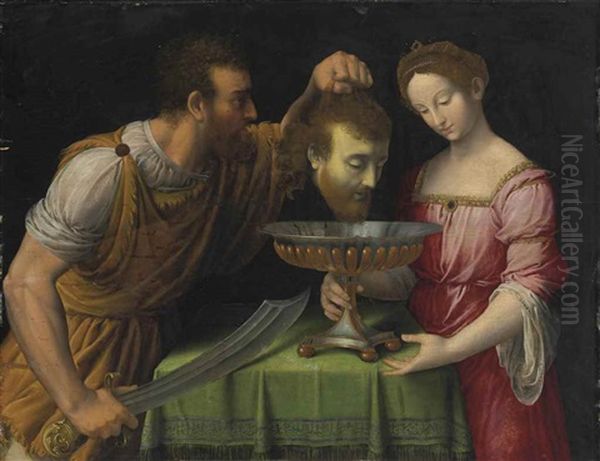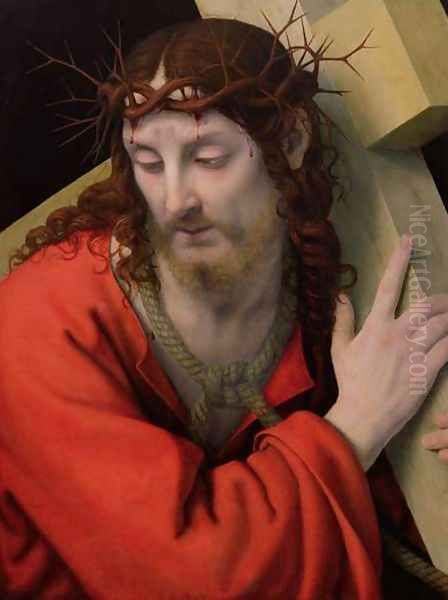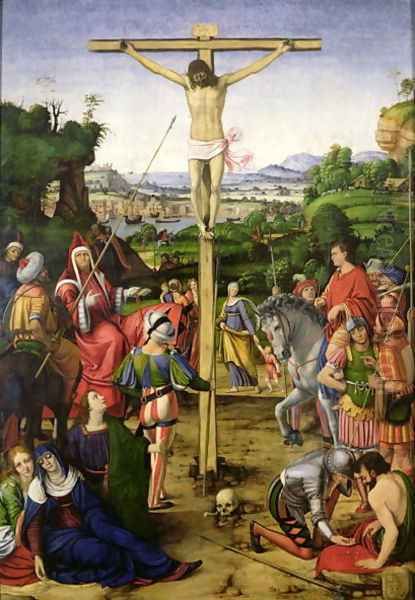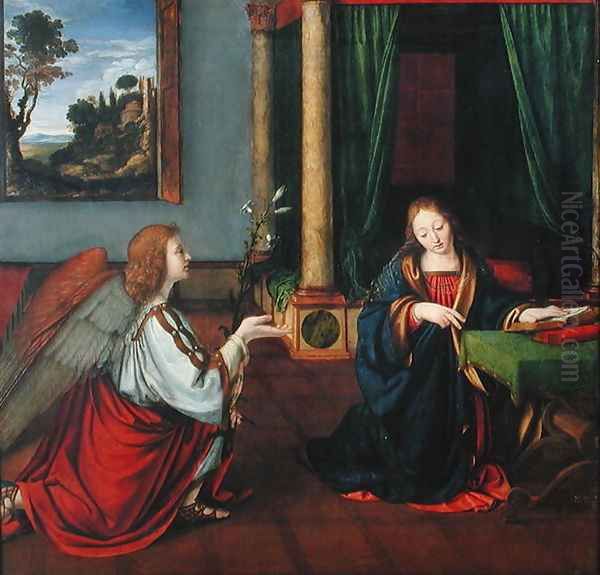Andrea Solario, also known as Andrea Solari, stands as a significant, if sometimes underappreciated, figure of the Italian High Renaissance. Active primarily in Milan but with crucial periods spent in Venice and France, Solario (c. 1460 – 1524) forged a distinctive artistic identity. His work is characterized by a sophisticated fusion of Lombard precision, the groundbreaking sfumato and psychological depth pioneered by Leonardo da Vinci, the rich colorism of the Venetian school, and a subtle yet discernible influence from Northern European art. As a painter of exquisite religious scenes and penetrating portraits, Solario navigated the complex artistic currents of his time, leaving behind a legacy of refined and emotionally resonant works.
Early Life and Artistic Genesis in a Family of Artists
Andrea Solario was born in Milan around 1460 into a family deeply embedded in the artistic and architectural trades. The Solari, or Solario, family, originally from Carona in the Ticino region, had a long-standing reputation as sculptors and architects. His elder brother, Cristoforo Solari (c. 1468/1470 – 1524), known as "Il Gobbo" (the Hunchback), was a highly respected sculptor and architect in his own right. Cristoforo's prominence, particularly his work on Milan Cathedral (Duomo di Milano) and the Certosa di Pavia, would undoubtedly have provided Andrea with an immersive artistic environment from his earliest years. It is highly probable that Andrea received his initial artistic training within this familial context, perhaps even assisting his brother, thereby gaining an early appreciation for form and structure that would later inform his painterly practice.
While Cristoforo pursued sculpture and architecture, Andrea became the first in this notable lineage to dedicate himself principally to painting. This decision marked a significant step, allowing him to explore a different medium yet still benefit from the family's established connections and reputation within Milan's artistic circles. The city of Milan, under the rule of the Sforza dukes, particularly Ludovico Sforza "Il Moro," was a vibrant cultural hub, attracting talent from across Italy and beyond, most notably Leonardo da Vinci, whose arrival in the early 1480s would irrevocably shape the course of Lombard art.
The Venetian Sojourn: Embracing Color and Light

A pivotal moment in Andrea Solario's early development occurred in the early 1490s when he accompanied his brother Cristoforo to Venice. Cristoforo had commissions in the Serenissima, and this journey exposed Andrea to a radically different artistic milieu than that of Milan. Venice, a maritime republic with strong trade links to Byzantium and Northern Europe, had cultivated a distinct artistic tradition that prioritized color (colorito) and light over the Florentine and Central Italian emphasis on drawing and design (disegno).
In Venice, Solario encountered the works of the leading masters of the Venetian school. He was profoundly influenced by Antonello da Messina (c. 1430–1479), a Sicilian painter who had himself masterfully synthesized Italian and Netherlandish techniques, particularly the use of oil glazes to achieve luminous color and meticulous detail. Antonello's precise rendering of form, his subtle modeling, and the psychological acuity of his portraits left a lasting impression on Solario. Furthermore, the dominant figure of Giovanni Bellini (c. 1430–1516) and his workshop was inescapable. Bellini's mastery of atmospheric effects, his harmonious color palettes, and the gentle, humanized piety of his Madonnas and saints provided Solario with a rich source of inspiration. One can also surmise exposure to other Venetian contemporaries like Vittore Carpaccio (c. 1460-1526) and Cima da Conegliano (c. 1459-1517), whose narrative clarity and serene landscapes respectively contributed to the city's artistic richness.
This Venetian experience was transformative. Solario absorbed the lessons of Venetian colorism, learning to build up forms through layers of translucent paint, achieving a depth and richness of hue that would become a hallmark of his style. His early works from this period, or immediately following, begin to show this burgeoning sensitivity to light and color, distinguishing him from many of his Lombard contemporaries. An early example, the Madonna and Child with Saints Joseph and Jerome (1495), painted for the Church of San Pietro Martire in Murano (now in the Pinacoteca di Brera, Milan), already demonstrates a sophisticated handling of oil paint and a thoughtful composition that reflects his Venetian studies, alongside a certain Northern European precision in the rendering of details.
Return to Milan and the Shadow of Leonardo

Upon his return to Milan around the mid-1490s, Solario found the artistic scene dominated by the towering presence of Leonardo da Vinci (1452–1519). Leonardo had been in Milan since circa 1482, working for Ludovico Sforza, and his revolutionary approach to painting – his use of sfumato (the subtle, smoky blending of tones and colors), his dynamic compositions, and his profound understanding of human anatomy and psychology – had a seismic impact on local artists. Many Lombard painters, including Giovanni Antonio Boltraffio (1466/67–1516), Ambrogio de Predis (c. 1455–c. 1508), and Marco d'Oggiono (c. 1470–c. 1524), became his followers, collectively known as the Leonardeschi.
Solario, while never a direct pupil in the same way as some others, was deeply receptive to Leonardo's innovations. He skillfully integrated Leonardo's sfumato technique into his own developing style, using it to soften contours, create a sense of atmospheric depth, and imbue his figures with a gentle, introspective quality. This is particularly evident in the delicate modeling of faces and the subtle transitions between light and shadow in his works from this period onwards. Unlike some Leonardeschi who merely imitated Leonardo's mannerisms, Solario assimilated these influences into a more personal synthesis, retaining elements of his Venetian learning and a certain Lombard clarity.
His Portrait of a Man with a Pink Carnation (c. 1495, National Gallery, London) showcases this evolving style, combining Venetian-inspired three-quarter pose and atmospheric background with a Leonardesque subtlety in the sitter's expression and the soft modeling of the features. The meticulous rendering of the carnation also hints at an appreciation for Northern European realism, possibly absorbed through Venetian channels or directly from imported works.
The Masterpiece: Madonna of the Green Cushion
Perhaps Solario's most famous and beloved work, the Madonna of the Green Cushion (La Vierge au coussin vert), now in the Musée du Louvre, Paris, is typically dated to around 1507-1510, though some scholars place it slightly earlier. This painting is a quintessential example of Solario's mature style, beautifully encapsulating his artistic strengths. The Virgin Mary is depicted with tender intimacy, gazing at the infant Christ who lies on a plush green cushion, a motif that gives the painting its name.

The composition is harmonious and balanced, with the figures rendered with a soft, sculptural quality. Leonardo's influence is palpable in the gentle sfumato that envelops the figures, particularly in the Virgin's serene face and the subtle modeling of the Child's flesh. However, the rich, jewel-like colors – the deep blue of Mary's mantle, the vibrant green of the cushion, and the warm flesh tones – speak to Solario's Venetian training and his mastery of the oil medium. The intimate, human portrayal of the mother and child, devoid of overt hierarchical stiffness, reflects the prevailing Renaissance humanism. The meticulous attention to detail, such as the delicate rendering of hair and the textures of the fabrics, further enhances the painting's appeal. This work became immensely popular and was frequently copied, attesting to its perceived success and devotional power.
The French Sojourn: Service to Cardinal d'Amboise
A significant chapter in Solario's career unfolded between 1507 and 1509 (or possibly extending to 1510), when he traveled to France at the behest of Cardinal Georges d'Amboise, Archbishop of Rouen and a powerful minister to King Louis XII. Louis XII had conquered Milan in 1499, and French patronage became an important avenue for Italian artists. Cardinal d'Amboise was a great connoisseur and patron of the arts, and he commissioned Solario to decorate the chapel of his magnificent Château de Gaillon in Normandy.
This French period was crucial for Solario. Working at Gaillon, he produced a series of frescoes depicting the lives of the Virgin and St. John the Baptist, as well as portraits and other easel paintings. While the frescoes themselves are largely lost or heavily damaged (fragments exist, including a Nativity in the Louvre), the experience likely broadened Solario's artistic horizons. In France, he would have encountered different artistic traditions, including late Gothic art and the emerging influences of the Northern Renaissance, possibly through artists like Jean Perréal (c. 1455–1530), who was active at the French court. This exposure may have reinforced his innate tendency towards detailed realism and refined execution.
His renowned Portrait of Charles II d'Amboise (c. 1507, Musée du Louvre), nephew of the Cardinal and French governor of Milan, likely dates from this period or shortly before his departure for France. It is a powerful character study, showcasing Solario's skill in capturing not only a physical likeness but also the sitter's commanding presence. The armor is rendered with brilliant precision, reflecting light, while the face is modeled with characteristic softness and psychological insight.
Mature Works and Artistic Characteristics

Upon his return to Italy, Solario continued to produce works of exceptional quality. His style had by now fully matured into a distinctive blend of influences. He retained the Lombard tradition of clear, well-defined forms, but softened by Leonardesque sfumato. His palette remained rich and luminous, a legacy of his Venetian experience, and his attention to detail, often reminiscent of Northern European masters like Jan van Eyck or Rogier van der Weyden (whose works were known in Italy), lent a tangible reality to his subjects.
Several key works exemplify his mature style:
_Salome with the Head of Saint John the Baptist_ (versions in the Kunsthistorisches Museum, Vienna, and the Metropolitan Museum of Art, New York, c. 1506-07 and c. 1520-24 respectively): These paintings demonstrate Solario's ability to convey dramatic narrative and intense emotion. The Vienna version, often considered earlier, shows Salome with a cool, almost detached beauty, contrasting with the grim reality of the Baptist's head. The later New York version is more overtly dramatic. The Head of St. John the Baptist (c. 1507, Musée du Louvre) is a fragment, possibly related to such a composition, and is remarkable for its poignant realism and delicate execution.
_Christ Carrying the Cross_ (Galleria Borghese, Rome, c. 1508-1510): A work of profound pathos, this painting focuses on Christ's suffering with a quiet intensity. The modeling of Christ's face, marked by sorrow and resignation, is particularly moving.
_Ecce Homo_ (Museum der bildenden Künste, Leipzig; another version in the Philadelphia Museum of Art, c. 1505-1510): These depictions of the flagellated Christ presented to the people are imbued with a deep sense of piety and human suffering, rendered with Solario's characteristic refinement.
_The Crucifixion_ (Musée du Louvre, c. 1503): An earlier but significant work, this painting displays a complex composition with numerous figures, set against a detailed landscape. It showcases Solario's narrative skill and his ability to orchestrate a multi-figure scene with clarity and emotional impact. The meticulous detail in the landscape and figures again points to Northern influences.
_Portrait of a Chancellor_ (Giovanni Bellini is sometimes credited, but Solario is a strong attribution; National Gallery of Art, Washington D.C., c. 1505-1515): This portrait demonstrates his keen observation and ability to convey the sitter's status and personality through pose, costume, and facial expression.

Solario's portraits are particularly noteworthy. He moved beyond mere representation to explore the psychological dimensions of his sitters, a trait undoubtedly sharpened by his engagement with Leonardo's work. His religious paintings, while adhering to traditional iconography, are infused with a gentle humanity and a palpable sense of devotion. He often favored half-length figures, allowing for a focus on facial expression and emotional interplay.
Uncertainties and Scholarly Debates
Despite his recognized talent, aspects of Solario's life and oeuvre remain subjects of scholarly discussion. The precise dates of his birth and death have some minor variations in historical records. While Milan is generally accepted as his birthplace, some older sources suggested origins in Naples or the Marches, though these theories have largely been discounted.
Attribution has also been a challenge. In the past, some of Solario's works were misattributed to other artists, including Giovanni Bellini, Leonardo da Vinci himself, or fellow Leonardeschi like Bernardino Luini (c. 1480/82–1532). This is a testament to the quality of Solario's painting and his ability to absorb and synthesize various influences. Modern scholarship, through connoisseurship and technical analysis, has done much to clarify his catalogue raisonné, but debates occasionally still arise over specific attributions or the dating of certain works. For instance, the influence of artists like Bramante (1444-1514), primarily an architect but also a painter active in Milan, or earlier Lombard masters like Vincenzo Foppa (c. 1427/30 – c. 1515/16), on the broader Milanese artistic environment that Solario inherited is also a topic of consideration for understanding his context.
Legacy and Influence
Andrea Solario died in Milan, likely in 1524. He left a significant mark on Lombard painting, particularly through his successful fusion of diverse artistic currents. He demonstrated how Leonardo's revolutionary techniques could be adapted and personalized without resulting in mere imitation. His emphasis on rich color, refined execution, and psychological depth provided a sophisticated alternative to some of the more formulaic productions of other Leonardeschi.
While it is difficult to trace direct, extensive tutelage of later famous artists, Solario's work contributed to the rich artistic tapestry of the High Renaissance. His paintings were admired and collected, and his particular synthesis of Leonardesque grace with Venetian color and Northern detail found resonance. His approach to portraiture, with its blend of formal dignity and psychological insight, was part of a broader European trend that would continue to develop throughout the 16th century. Artists like Albrecht Dürer (1471-1528), who traveled to Venice and was keenly aware of Italian developments, participated in a similar cross-cultural exchange of ideas.

The assertion that he directly influenced giants like Piero della Francesca (c. 1415–1492) is chronologically problematic, as Piero was an earlier master. However, Solario's work, particularly its clarity and refined modeling, can be seen as part of a lineage of Northern Italian art that valued these qualities, qualities also central to Piero's art. Regarding Tintoretto (1518–1594), a later Venetian master, any influence would be indirect; Tintoretto would have been aware of the broader artistic heritage, including works by artists like Solario that exemplified the rich interplay between Lombard and Venetian traditions. Solario's paintings remained in important collections and churches, serving as examples of High Renaissance mastery for subsequent generations.
Conclusion: An Artist of Refined Synthesis
Andrea Solario emerges as a painter of considerable talent and sophistication. He was not merely an eclectic artist borrowing from various sources, but a master synthesizer who forged a personal and coherent style. His ability to absorb the lessons of Leonardo da Vinci without being overwhelmed by his genius, while simultaneously integrating the chromatic richness of Venice and the meticulous detail of Northern European art, marks him as a distinctive voice in the Italian Renaissance. His Madonnas radiate a tender humanity, his religious narratives are imbued with quiet pathos, and his portraits capture the essence of his sitters with penetrating insight. Though perhaps not as universally renowned as some of his contemporaries, Andrea Solario's contribution to the art of the High Renaissance is undeniable, and his works continue to be admired for their elegance, technical brilliance, and profound emotional depth. He remains a testament to the rich cross-currents of artistic exchange that characterized one of the most fertile periods in European art history.